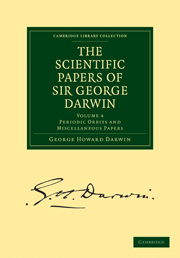Book contents
- Frontmatter
- PREFACE
- Contents
- Chronological List of Papers with References to the Volumes in which they are contained
- Errata
- PART I PERIODIC ORBITS
- PART II THE TIDES
- PART III MISCELLANEOUS PAPERS IN CHRONOLOGICAL ORDER
- 5 On some Proposed Forms of Slide-rule
- 6 An Application of Peaucellier's Cell
- 7 The Mechanical Description of Equipotential Lines
- 8 On a Mechanical Representation of the Second Elliptic Integral
- 9 On Maps of the World
- 10 A Geometrical Puzzle
- 11 A Geometrical Illustration of the Potential of a Distant Centre of Force
- 12 On Graphical Interpolation and Integration
- 13 On a Theorem in Spherical Harmonic Analysis
- 14 On Fallible Measures of Variable Quantities, and on the Treatment of Meteorological Observations
- 15 On the Horizontal Thrust of a Mass of Sand
- 16 On the Formation of Ripple-mark in Sand
- 17 Note on Mr Davison's Paper on the Straining of the Earth's Crust in Cooling
- 18 On the Mechanical Conditions of a Swarm of Meteorites, and on Theories of Cosmogony
- 19 On the Perturbation of a Comet in the Neighbourhood of a Planet
- 20 The Eulerian Nutation of the Earth's Axis
- 21 The Analogy between Lesage's Theory of Gravitation and the Repulsion of Light
- PART IV PAPERS ON TIDES (Supplementary to Volume I)
- PART V ADDRESSES TO SOCIETIES
- APPENDIX
- INDEX
- Plate section
21 - The Analogy between Lesage's Theory of Gravitation and the Repulsion of Light
Published online by Cambridge University Press: 07 September 2010
- Frontmatter
- PREFACE
- Contents
- Chronological List of Papers with References to the Volumes in which they are contained
- Errata
- PART I PERIODIC ORBITS
- PART II THE TIDES
- PART III MISCELLANEOUS PAPERS IN CHRONOLOGICAL ORDER
- 5 On some Proposed Forms of Slide-rule
- 6 An Application of Peaucellier's Cell
- 7 The Mechanical Description of Equipotential Lines
- 8 On a Mechanical Representation of the Second Elliptic Integral
- 9 On Maps of the World
- 10 A Geometrical Puzzle
- 11 A Geometrical Illustration of the Potential of a Distant Centre of Force
- 12 On Graphical Interpolation and Integration
- 13 On a Theorem in Spherical Harmonic Analysis
- 14 On Fallible Measures of Variable Quantities, and on the Treatment of Meteorological Observations
- 15 On the Horizontal Thrust of a Mass of Sand
- 16 On the Formation of Ripple-mark in Sand
- 17 Note on Mr Davison's Paper on the Straining of the Earth's Crust in Cooling
- 18 On the Mechanical Conditions of a Swarm of Meteorites, and on Theories of Cosmogony
- 19 On the Perturbation of a Comet in the Neighbourhood of a Planet
- 20 The Eulerian Nutation of the Earth's Axis
- 21 The Analogy between Lesage's Theory of Gravitation and the Repulsion of Light
- PART IV PAPERS ON TIDES (Supplementary to Volume I)
- PART V ADDRESSES TO SOCIETIES
- APPENDIX
- INDEX
- Plate section
Summary
I am not aware that anyone has taken the trouble to work out Lesage's theory, except in the case where the particles of gross matter, subjected to the bombardment of ultramundane corpuscles, are at a distance apart which is a large multiple of the linear dimensions of either of them. Some years ago I had the curiosity to investigate the case where the particles are near together, and having been reminded of my work by reading Professor Poynting's paper on the pressure of radiation, I have thought it might be worth while to publish my solution, together with some recent additions thereto.
If a corpuscle of mass m moving with velocity v impinges on a plane surface, so that the inclination of its direction of motion before impact to the normal to the surface is ϑ, it communicates to the surface normal momentum kmv cos ϑ, and tangential momentum k′mv sin ϑ; where k is 1 for complete inelasticity, and 2 for perfect elasticity, and k′ is 0 for perfect smoothness and 1 for perfect roughness.
In the following paper the effects are investigated of the bombardment by Lesagian corpuscles of two spheres, which are taken to be types of the atoms or molecules of gross matter. The effects of the normal and tangential components of the momentum communicated by each blow from a corpuscle will be treated separately.
- Type
- Chapter
- Information
- The Scientific Papers of Sir George DarwinPeriodic Orbits and Miscellaneous Papers, pp. 446 - 470Publisher: Cambridge University PressPrint publication year: 2009First published in: 1911



